Choosing the Right Wood Stove for Your Off-Grid Cabin: A Size Guide
- November 28, 2023
- 0 comment
Looking for the perfect wood stove for your off-grid cabin? Our guide makes it simple. We’ll help you weigh up the size, efficiency, and eco-friendliness of your options to ensure you pick a stove that not only heats up your space but also aligns with your eco-conscious lifestyle. Living off-grid, especially in cooler climates, means having a reliable heat source is crucial — not just for comfort but for survival.

The wood stove, a time-tested solution, offers more than just heat; it brings a rustic charm and a dependable warmth to your cabin retreat. Let’s dive into how to select the right stove for your needs, considering everything from stove sizing and energy efficiency to environmental impact and the latest advancements in stove technology.
1. Fireplace vs. Wood Burning Stove
When setting up your off-grid cabin, a crucial choice is between installing a traditional fireplace or opting for a wood-burning stove. Fireplaces, with their classic charm, add significant aesthetic value to any space. However, they are often less efficient in terms of heat distribution. A significant amount of heat is lost through the open front, and there’s an increased risk of fire hazards due to sparks. On the other hand, free-standing wood stoves present a more efficient and safer alternative.
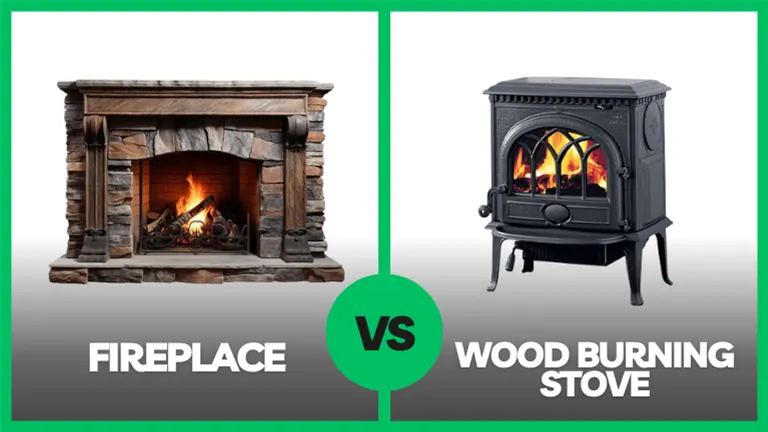
These stoves are designed to control the burn rate of wood, offering a more consistent and safer heat source. They excel in radiating heat in all directions – a 360-degree spread – which is particularly beneficial in the cold climate of an off-grid setting. Additionally, when paired with masonry stone walls, wood stoves not only enhance the aesthetic appeal but also significantly improve heat retention, ensuring your cabin remains warm and cozy. This comparison underscores the importance of considering both functionality and safety alongside aesthetic preferences in choosing the right heating option for your off-grid cabin.
2. Sizing Your Stove Correctly
Choosing the correct size for your wood stove is a critical step in optimizing the efficiency and cost-effectiveness of your heating solution. A common mistake is overestimating the size needed, which can lead to higher fuel consumption and unnecessary expenses. For homes or cabins covering 2,000 to 3,000 square feet, a wood stove with a firebox capacity ranging from 2 to 2.5 cubic feet is typically adequate. This size ensures enough heat output to keep larger spaces comfortably warm without overburdening. In contrast, for smaller areas such as garages or more compact cabins, a stove with a firebox of 1 to 1.5 cubic feet is usually sufficient.
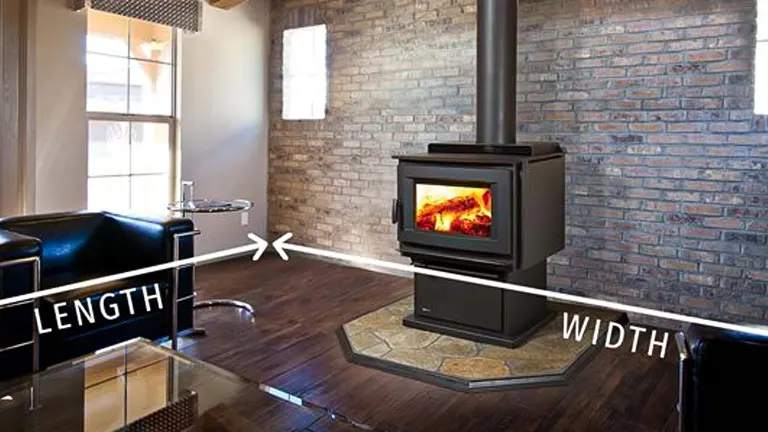
This smaller size can efficiently meet the heating demands of a reduced space, maintaining comfort while conserving fuel. To find the right heat output needed for your space, calculate 20 BTUs for every square foot of heating area. For example, if you are heating a space that’s 1,500 square feet, you’ll want a stove with at least 30,000 BTUs. The key is to align the stove’s capacity with the specific dimensions and heating requirements of your space, ensuring that you have a wood stove that performs optimally, both in terms of heating efficiency and fuel usage.
3. Efficiency and EPA Standards
Efficiency is a cornerstone in the world of wood stoves, impacting not only your wallet but also the environment. High-efficiency wood stoves translate to significant savings by reducing the amount of wood you need to chop and haul, consequently minimizing your environmental footprint. When selecting a wood stove, it’s essential to consider models that meet or exceed the Environmental Protection Agency (EPA) standards. Stoves with EPA-listed efficiencies of 70% or higher are recommended. They are designed to burn wood more completely, producing more heat with less fuel and reducing emissions.

Advancements in technology have further enhanced the efficiency of modern wood stoves. For instance, models that have smart thermostat technology. This innovation allows for more precise control over the burning process, potentially increasing real-world efficiency by an impressive 20 to 25%. Such stoves offer an excellent balance of performance and environmental responsibility, ensuring that your heating method is as green as it is effective. By opting for a high-efficiency wood stove that aligns with EPA standards, you’re not only optimizing your heating solution but also contributing to a healthier, more sustainable environment.
Looking for the Best EPA-Certified Wood Stoves? Check it out here Best EPA-Certified Wood Stoves 2023
4. Adhering to Clean Air Regulations
In the pursuit of a more eco-friendly and health-conscious heating solution, adherence to the latest EPA regulations is crucial when selecting a wood stove. Recent updates to these regulations have set stringent limits on smoke emissions, capping them at 2.0 grams per hour. This new standard renders many older wood stove models non-compliant and effectively obsolete.

When shopping for a wood stove, it’s imperative to choose a model that meets or surpasses these clean air standards. Not only does this ensure legal compliance, but it also significantly contributes to a healthier living environment. Stoves that align with these regulations are designed to burn wood more efficiently and cleanly, reducing the amount of particulate matter released into the atmosphere. This is particularly important for off-grid cabin owners who value both the purity of their natural surroundings and the well-being of the planet. By opting for a wood stove that adheres to the latest EPA emissions standards, you’re making a responsible choice that benefits both your immediate living space and the wider environment.
5. Catalytic vs. Non-Catalytic Fireboxes
The choice between catalytic and non-catalytic fireboxes is crucial when selecting a wood stove for your off-grid cabin. Catalytic wood stoves, which have evolved significantly since their introduction in the 1980s, feature a combustor that can last over a decade with proper care. This technology allows them to burn wood more efficiently, producing more heat with less fuel and reducing emissions. This makes catalytic stoves a great option for those prioritizing environmental sustainability and cost-effectiveness.

Non-catalytic wood stoves, on the other hand, are valued for their simplicity and ease of use, making them ideal for those new to wood burning. These stoves typically require less maintenance and are easier to operate, but they may not match the efficiency or environmental friendliness of catalytic models. They tend to produce more emissions and do not burn wood as completely. When deciding between the two, consider what’s more important for your needs: the high efficiency and lower emissions of catalytic stoves or the user-friendly and potentially lower upfront cost of non-catalytic stoves. Understanding these differences will help you choose the right type of stove for your cabin’s heating needs.
6. The Rise of Smart Wood Stoves
The integration of technology into home heating has led to the rise of smart wood stoves, a significant advancement from traditional models. These stoves integrate features like automatic igniters and remote burn control, enhancing user convenience and safety. The automatic igniters simplify the ignition process, eliminating the traditional challenges and risks associated with starting a fire manually. Additionally, remote burn control allows users to adjust the burn rate and temperature from afar, ensuring optimal comfort without frequent manual adjustments.
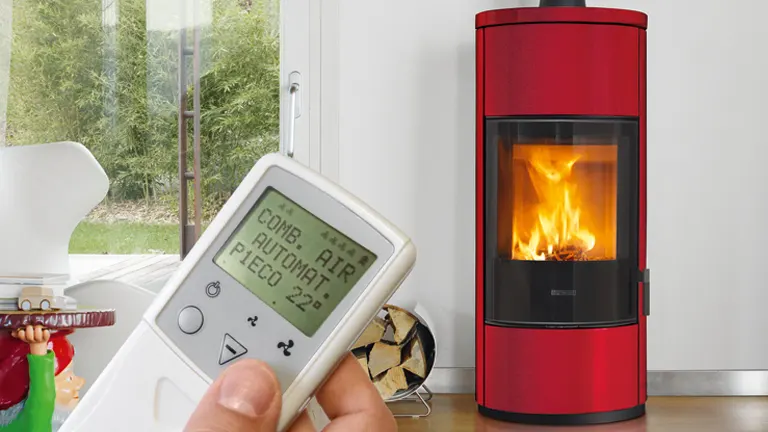
Although smart wood stoves come with a higher initial cost, the investment is offset by their convenience, especially for those who may find operating traditional stoves physically demanding. This includes the elderly, people with physical limitations, or those who prefer a more automated approach to heating. The user-friendly and safe operation of smart wood stoves broadens their appeal, making wood-burning a viable option even in our tech-driven era. These stoves maintain the ambiance and heating efficiency of traditional wood burning while embracing the enhancements that modern technology offers.
7. The Wood Lifestyle
Choosing a wood stove isn’t just about adding a heat source; it’s about embracing a whole lifestyle deeply connected with nature. This ‘wood lifestyle’ encompasses the physical tasks of collecting, stacking, and handling wood, linking you closely to nature’s cycles and seasons. While it can be physically demanding, it also provides substantial physical exercise, mindfulness, and a sense of achievement.
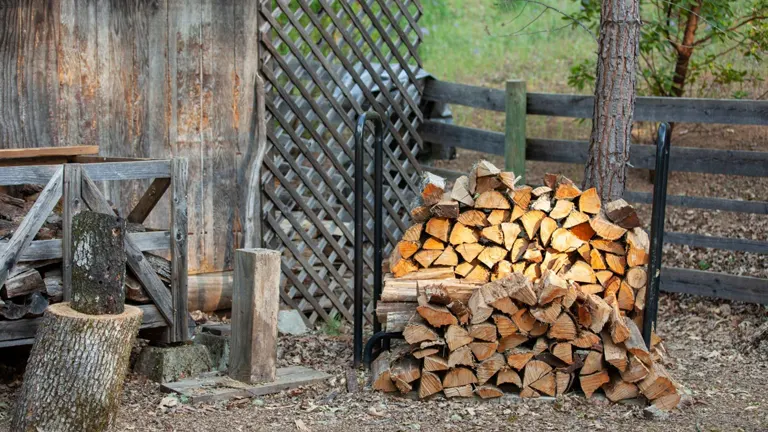
This lifestyle cultivates a close relationship with the environment, involving an understanding of different wood types, their burning properties, and sustainable harvesting practices. It offers more than warmth; it brings a sense of environmental stewardship and a deeper appreciation for natural resources. Additionally, the wood lifestyle offers a grounding escape from our fast-paced, tech-driven world, promoting patience and a connection to a simpler, elemental way of living. For many, it’s about valuing self-sufficiency, environmental responsibility, and the therapeutic act of working with wood.
Conclusion
Selecting the ideal wood stove for your off-grid cabin is a nuanced decision that requires weighing several key factors. Size, efficiency, and adherence to environmental regulations are paramount in ensuring that your heating solution is both practical and sustainable. Additionally, aligning this choice with your personal lifestyle preferences – whether it be the simplicity and tradition of a non-catalytic stove or the advanced features of a smart, catalytic model – is crucial for long-term satisfaction.
By thoughtfully considering these elements, you can secure a heating option that not only keeps your cabin cozy and warm but also aligns with your environmental values and way of life. A well-chosen wood stove goes beyond mere functionality; it becomes an integral part of your cabin’s character and charm. It enhances the rustic ambiance while providing a dependable and eco-friendly source of warmth. In essence, the right wood stove is not just an appliance but a key component of your off-grid living experience, contributing to both the efficiency and the aesthetic appeal of your cherished retreat.
FAQs
- Can the design of my cabin influence the type of wood stove I should choose?
Yes, the design and layout of your cabin can significantly influence your wood stove choice. For instance, open-plan cabins may require a stove with a broader heat distribution, while cabins with multiple small rooms might benefit from a stove with a built-in blower to circulate heat more effectively. - Is it possible to cook on a wood stove, and what should I look for if I want this feature?
Absolutely! Many wood stoves come with flat top surfaces that can be used for cooking. If you’re interested in this feature, look for stoves with a substantial, flat top surface and consider the stove’s heat control capabilities to facilitate cooking. - How does altitude affect the performance of a wood stove?
Altitude can impact the air pressure and oxygen levels, which in turn affects combustion in a wood stove. At higher altitudes, you might need a stove that’s designed for efficient burning in thinner air to ensure optimal performance. - Are there eco-friendly wood stoves that reduce carbon footprint?
Yes, modern wood stoves are designed to be more eco-friendly. Look for stoves with high EPA ratings and low emissions. Some stoves are also designed to burn renewable biomass fuels, which can further reduce your carbon footprint. - What safety features should I look for in a wood stove for my cabin?
Key safety features include a sturdy, well-insulated body, a reliable door latch, and a controlled air intake mechanism. Additionally, some stoves offer safety features like automatic overheat shut-off or heat shields to reduce the risk of accidental burns.
I hope this guide helps you choose the perfect wood stove for your off-grid cabin! Have you tried any of these stoves, or do you have tips for living the wood stove lifestyle? Share your experiences and suggestions in the comments below. Let’s keep the conversation burning!

David Murray
Forestry AuthorI'm David Murry, a forestry equipment specialist with a focus on chainsaw operation. With over 13 years of experience, I've honed my skills in operating and maintaining a wide range of machinery, from chainsaws to log splitters. My passion for the outdoors and commitment to sustainable forestry drive my work, which emphasizes safety, efficiency, and staying updated with industry advancements. Additionally, I'm dedicated to sharing my expertise and promoting environmental awareness within the forestry community.





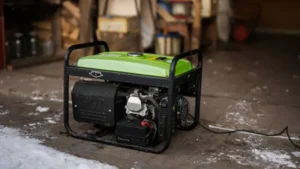







Leave your comment